Death, Taxes, and Severe Weather
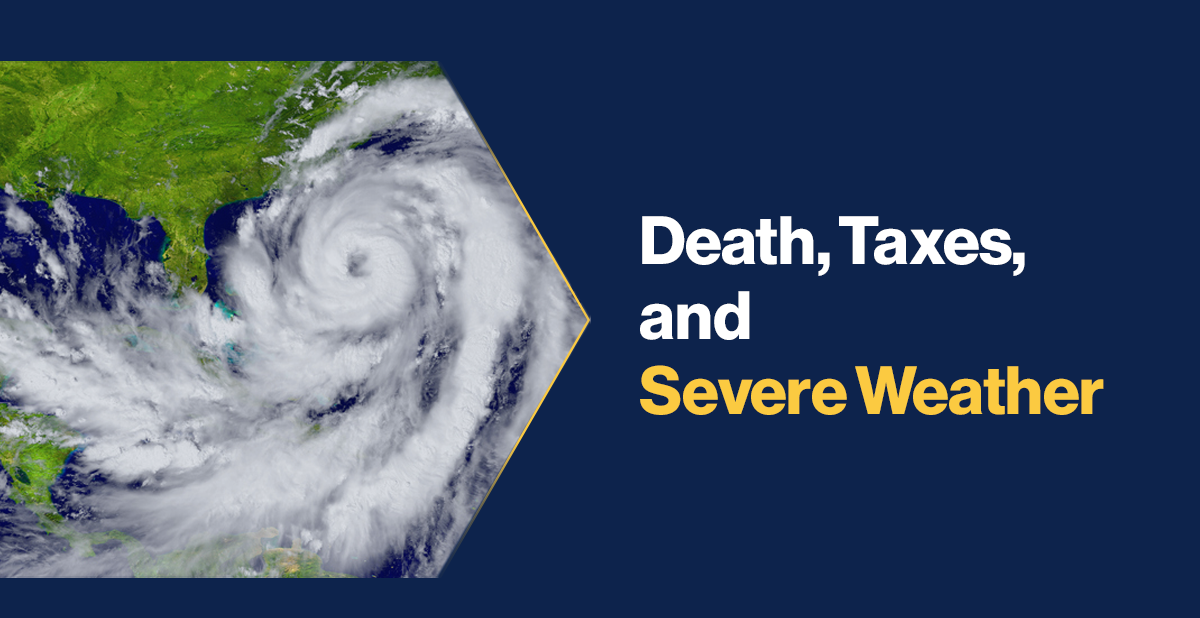
Nothing in life is certain except for death and taxes. I would like to raise the motion to include severe weather to the expression. Somewhere in the world at this very moment, a storm is wreaking havoc. Those in favour, say Aye…
In the 2020 the Business Continuity Institute (BCI) Horizon Scan Report, extreme weather events ranked third on the risk index for their perceived high likelihood and impact to operations. The changing climate has led to an increase in the frequency and severity of adverse weather events. Couple this with human and infrastructure exposure in wildfire and flood-prone areas, and it’s a recipe for job security – Ermm… disaster.
TELUS, a Canadian telecommunications company with over 13.4 million subscriber connections, was recently awarded the 2020 BCI Americas Most Effective Recovery award for our crisis management efforts to wildfires in northern Alberta, Canada. This article will discuss how TELUS developed a program to proactively monitor, prepare for, and minimize the impacts of severe weather on its infrastructure and the services it provides its customers.
Forecasting and monitoring
With wireless coverage to 99.9% of Canadians, TELUS has a vast network that spans from Vancouver, British Columbia to St. Johns, Newfoundland. For our friends outside of Canada, that’s a 7200km drive on the Trans-Canada highway. Our extensive infrastructure footprint inherently exposes us to severe weather threats. Similarly, commercial power which is telecommunications’ greatest dependency, also suffers the same fate.
If there’s one silver lining to severe weather events, it’s that modern weather technology affords us the luxury to forecast. Advanced warnings will buy your organization valuable time so that you may proactively prepare and mitigate impact.
You can find the weather experts by leveraging your social network or even making cold calls. In Canada, Environment Canada maintains regional offices outfitted with local Warning Preparedness Meteorologists. That’s how I learned of advanced weather notifications designed to give the emergency management community a heads up on potential adverse weather that’s still too early to forecast with high confidence. Speed is of the essence. Knowing what’s on the horizon before an official alert is published will buy you valuable time.
There are many vendors offering weather intelligence solutions including automated alerts and active monitoring and forecasting. We explored those options but while they didn’t make sense for us, it might for your organization. Here are some of the ways we forecast and monitor severe weather threats.
Long-term forecasting
As it does for taxes, spring signals the start of the wildfire and spring flooding season in Canada. We conduct bi-annual workshops in the spring and fall to provide intel on seasonal trends and threats that are fundamental to preparedness and mitigation planning. Though these workshops are open to all team members, we target key operational and strategic teams such as core network and field services teams, real estate, and business unit incident management teams.
What do we cover in the workshops? First, we look at the underlying climate indicators that influence weather. How will cyclical climatic systems affect weather development? We collate forecasts from agencies such as Environment Canada and the National Oceanic and Atmospheric Administration (NOAA) to determine how climatic indicators such as the El Niño Southern Oscillation (ENSO) may influence weather. For instance, hurricane formation in the Atlantic is diminished when El Niño conditions are present, and we typically experience increased snowfall in British Columbia when La Niña conditions are present.
We then take a closer look at seasonal threats and trends at the regional level. Wildfire agencies use factors such as long-range temperature and precipitation forecasts, available forest fuel, and drought conditions to forecast the severity of the wildfire season and identify regions with elevated risk. Waterway agencies look at available snowpack, temperature and precipitation forecasts, and water supply to forecast spring flooding risk. Based on our research and analysis, we assign wildfire and flooding risk severity ratings for each Canadian province.
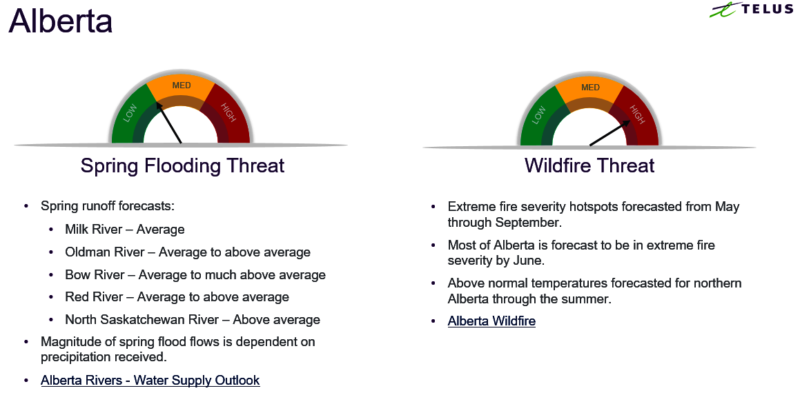
Long-term forecasts enable our network resilience teams to more effectively focus our preparedness and mitigation efforts to higher-risk regions. For instance, we can be more deliberate in where we stage flood barriers and equipment, and prioritize sites for brush clearing – more on this later.
Keep in mind that advanced seasonal forecasts are only part of the equation. Waterway authorities have suggested that available snowpack accounts for only a portion of the flood risk. Near-term weather will dictate how seasonal threats materialize. Prolonged hot conditions accelerating snowmelt and sustained rainfall can cause overland flooding even in areas with below average snowpack. Conversely, areas with above average snowpack may not experience flooding at all absent those conditions.
Near-term surveillance
We publish a weekly severe weather outlook every Monday. Are there storms on the horizon? Where and when will they take place? Will prolonged rainfall increase the risk for flooding? Are there strong gusty winds that could cause widespread power outages? Our objective is to brief tactical, strategic, and operational teams with near-term adverse weather conditions to increase awareness so that they may plan their work week accordingly. They might for example, consider deferring maintenance work or implement a change embargo to reduce risk to the network and team members.
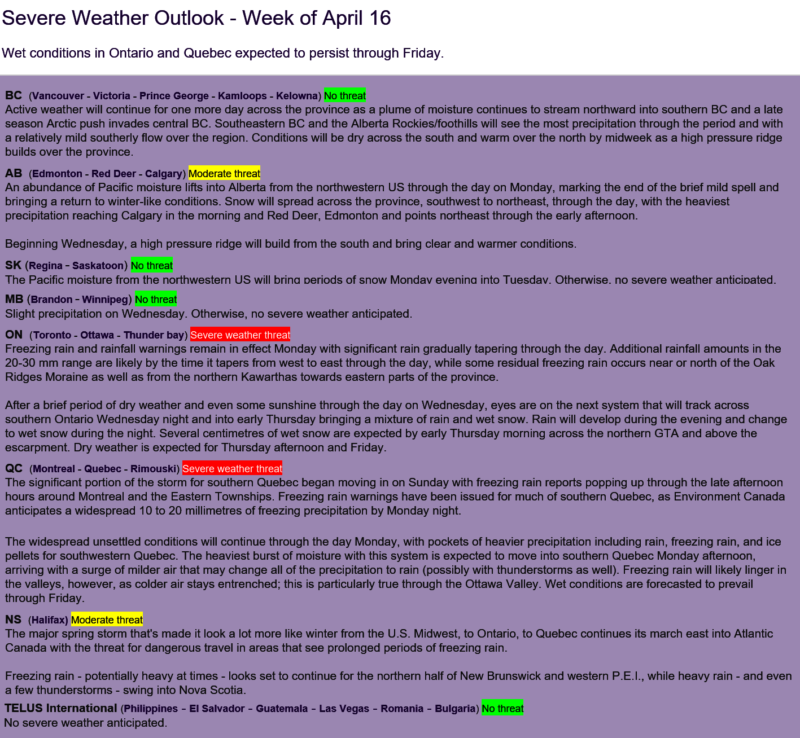
The outlook typically takes 45 to 90 minutes to publish. We leverage forecasts from government agencies and weather media outlets to create a 7-day outlook for jurisdictions where TELUS operates. We rank the severity for each region with a traffic light system: Severe (red), Moderate (yellow), No Threat (green).
A culture of resilience starts from the top. When a severe threat is identified, the Executive Leadership Team is notified.
Immediate-term monitoring
While near-term surveillance is great for strategic planning, it does have limitations. Weather forecasts tend to lose accuracy beyond 72 hours. For this reason, we also actively monitor weather in the immediate term. This process is supported by a severe weather playbook that shows how we monitor for adverse weather, the regional thresholds of when it could impact our operations, and who needs to be notified.
Who does the monitoring, and how? A 24x7 team actively monitors for adverse weather taking place over the next 24 to 48 hours. They monitor weather media outlets, social media, and Environment Canada’s warnings and alerts. We also receive advanced weather notifications from government and partner organizations.
It’s common to receive hundreds of alerts and warnings every month. How do we determine when it’s a threat to operations? Weather forecasts are cross-referenced against tailored regional thresholds. These thresholds were developed in collaboration with regional managers who have knowledge of local weather and geography, and the general environment.
Think of this as a Business Impact Analysis (BIA) on weather. What’s the potential impact on operations if it snows more than 50 cm in Calgary? What about 100 kph winds in Metro Vancouver? This will require ongoing maintenance and tweaking until you find the appropriate thresholds. Finding the right balance is imperative to avoiding notification fatigue.

When alerts and warnings meet thresholds, regional managers are notified. For high-risk events, a conference bridge is initiated to discuss preparedness, mitigation, and/or response measures. What’s at risk? Do we have sufficient staffing levels? This is especially important if it’s taking place over a weekend or holidays. Are generators fueled and ready to go?
In a nutshell, weather forecasting and monitoring are about heightened vigilance for adverse weather, understanding the threat to operations, and informing those that need to know so that they can proactively prepare, mitigate the risk, or respond.
Preparedness and Mitigation
IT and telecommunication outages ranked second in the 2020 BCI risk index. This is unsurprising given how intertwined telecommunications have become into the fabric of daily life. Telecommunications also play a critical role in public safety by keeping communities and emergency responders connected during emergencies. For those reasons, the telecommunications industry places great emphasis on resilience and reliability. Below are some of the strategies we employ to address wildfire and flooding threats. After all, timely and qualified intel is only as good as what you do with it.
Brush clearing of remote assets
TELUS has an extensive rural network including in remote forested areas where wildfires are more prevalent. Network teams conduct annual brush clearing of remote sites in anticipation of the wildfire season. This means ‘firesmarting’ the perimeter around assets by clearing brush, debris, and other forest fuels. Some sites are cleared annually while some are done every other year. Site prioritization and the size of the perimeter is determined by a risk assessment that considers the type of asset and potential risk.
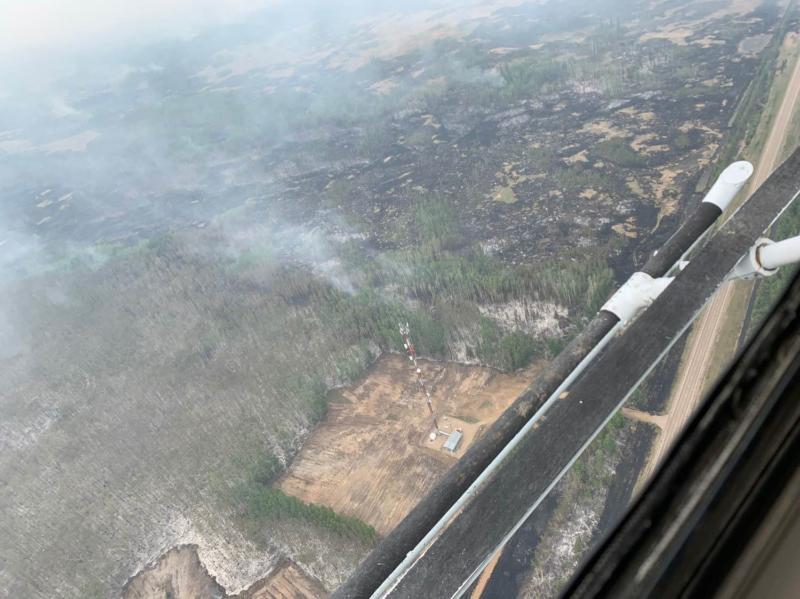
While brush clearing activities are costly, a cost-benefit analysis demonstrates that mitigating impact to just one site will produce a return on investment. Not to mention, keeping our customers, communities, and emergency responders connected during an emergency is an unquantifiable benefit.
Flood controls
Floods can significantly impact telecommunication networks. Unlike wildfires which predominantly occur in rural areas, floods also threaten urban environments where there’s a concentration of high-value network sites and last mile connections to customer premises. As part of an ongoing risk reduction program, TELUS conducts non-structural mitigation activities such as relocating network equipment, batteries, and generators to higher ground in flood-prone areas.
Flood tubes and barriers form the last line of physical defense against flooding. There are many vendors in this space. Though we continue to maintain those relationships, we understand their services will be in high demand in the event of widespread flooding. TELUS maintains its own fleet of flood trailers equipped with flood tubes and barriers, hoses and pumps, tools, and flood tube repair kits. TELUS also maintains an inventory of sandbags for sites where flood tubes are not viable for deployment.
The program is exercised and maintained annually. It’s an opportunity to assess the condition of the equipment, exercise deployment, identify gaps in the inventory, and determine which sites are viable for flood tube and/or sandbags.
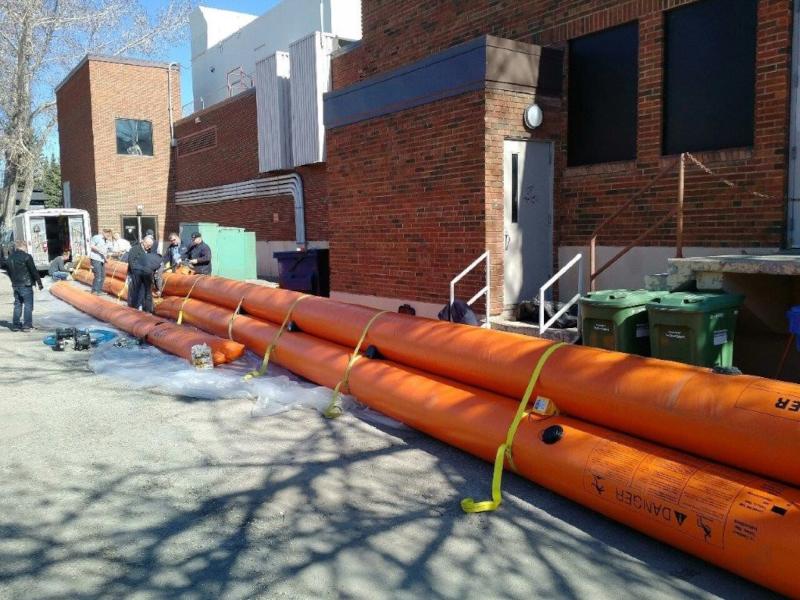
As with brush clearing for wildfires, maintaining and deploying flood controls are costly. However, mitigating impact to just one site will net a significant return on investment.
In the 2013 southern Alberta floods, the costliest Canadian disaster at the time, TELUS deployed flood tubes to protect a critical network site which hosted regional services. While flood waters did manage to enter the basement, major impact costing millions in equipment and restoration were largely mitigated.
Conclusion
The frequency of adverse weather and the seasonality of threats such as wildfires and spring flooding justify why business continuity and emergency managers consider extreme weather a major threat to operations. However, perhaps more than any other risk, the impacts of severe weather are actionable and controllable.
Develop a program that gets you timely and qualified intel, understand how it could hurt your organization, and have measures in place to eliminate or mitigate impact. Leverage local and organizational knowledge to account for the uniqueness of each site and region. Exercise the program to find opportunities for improvement and to ensure everyone can perform their roles effectively.
There will be learning pains. Be patient and preach patience to your stakeholders. Set the expectation that the program is dynamic and will evolve as you adapt new learnings.
Death, Taxes, and Severe Weather. I’m not a mortician nor an accountant, but I hope my experience in developing and managing a severe weather program provides you with a nugget or two to help your organization weather the storm.
Ramon Zulueta, Risk Management Manager, TELUS

